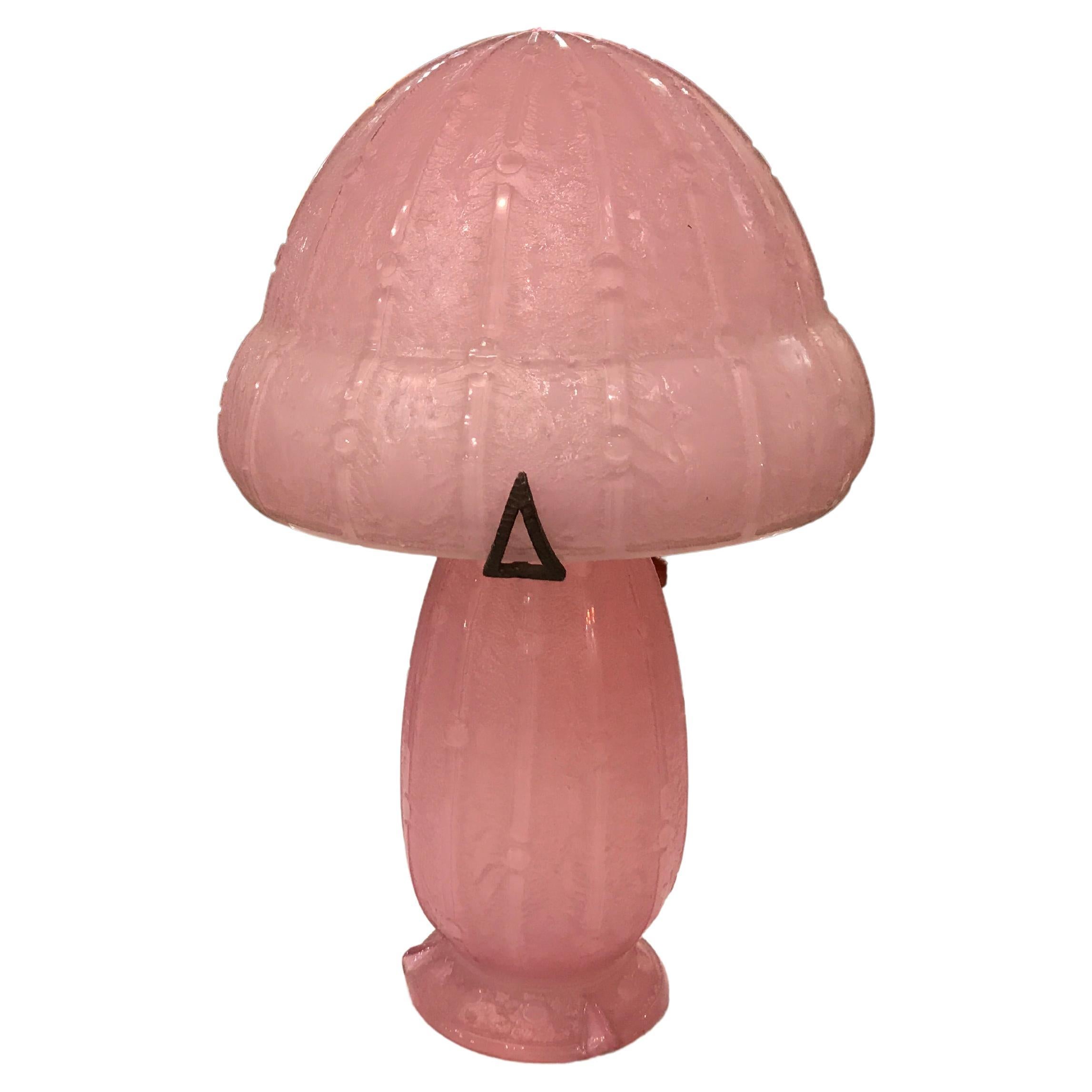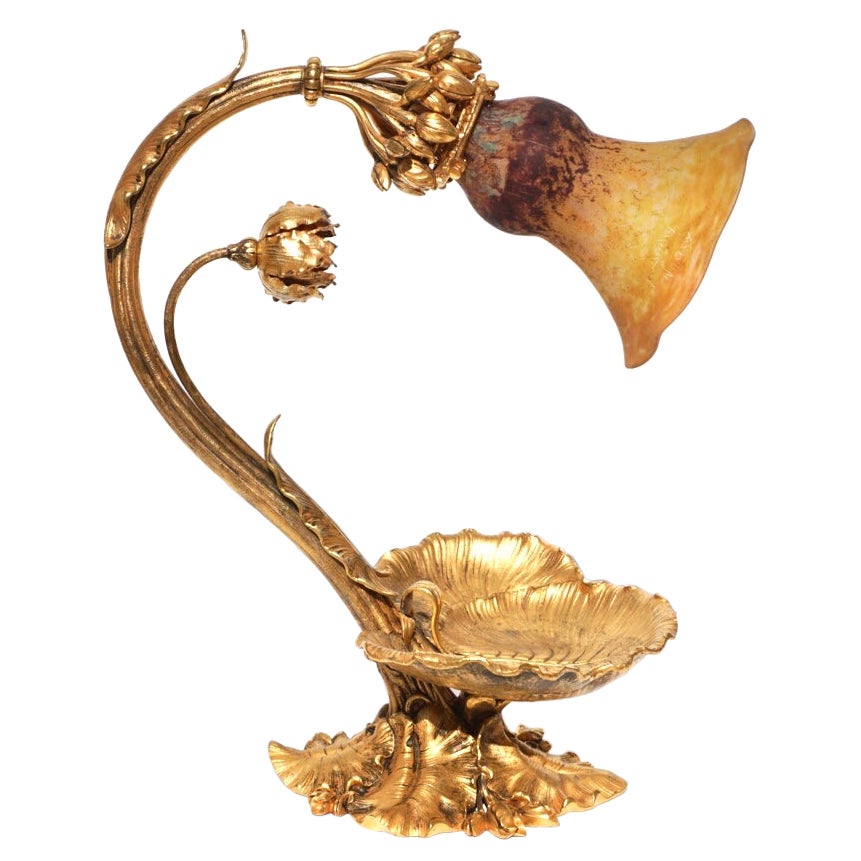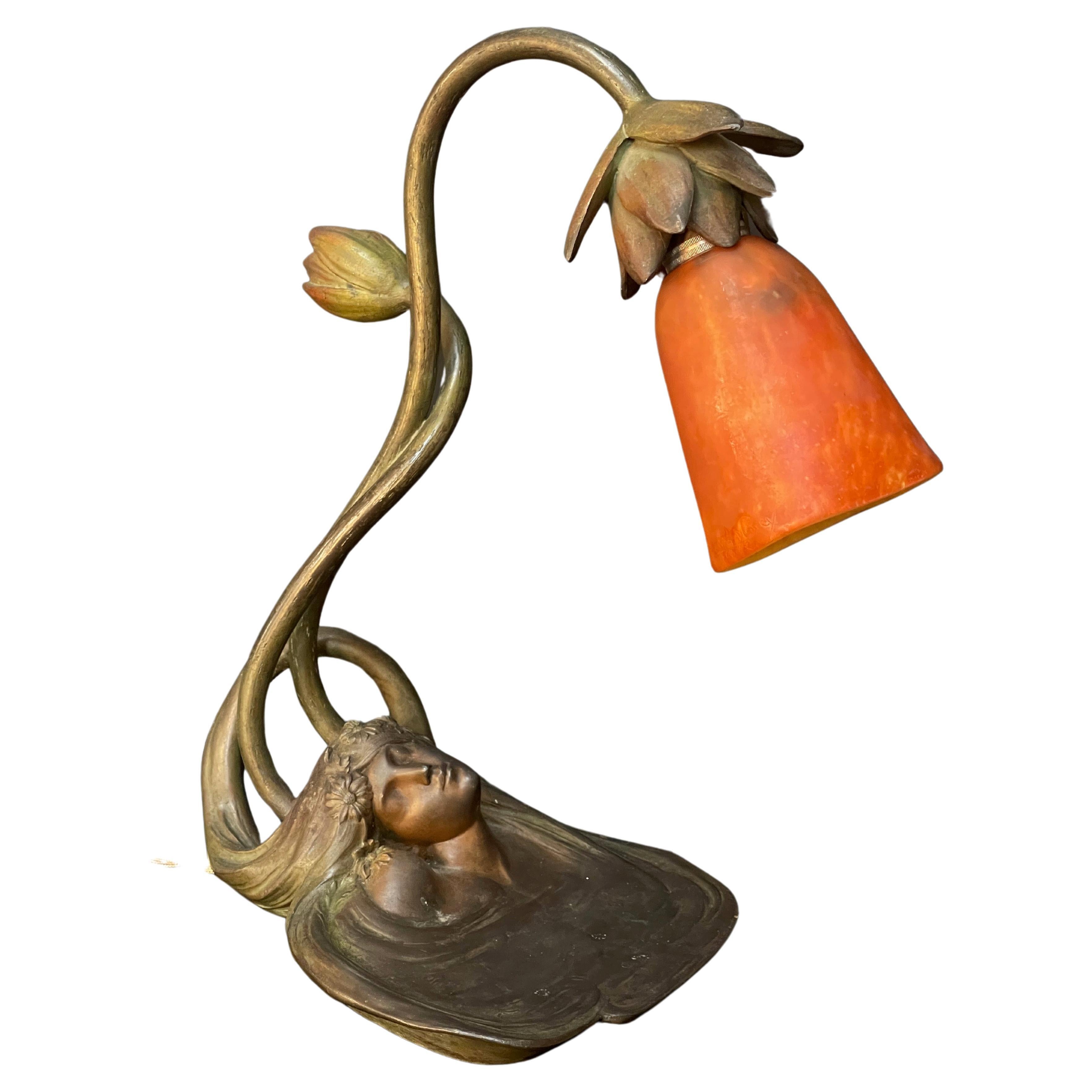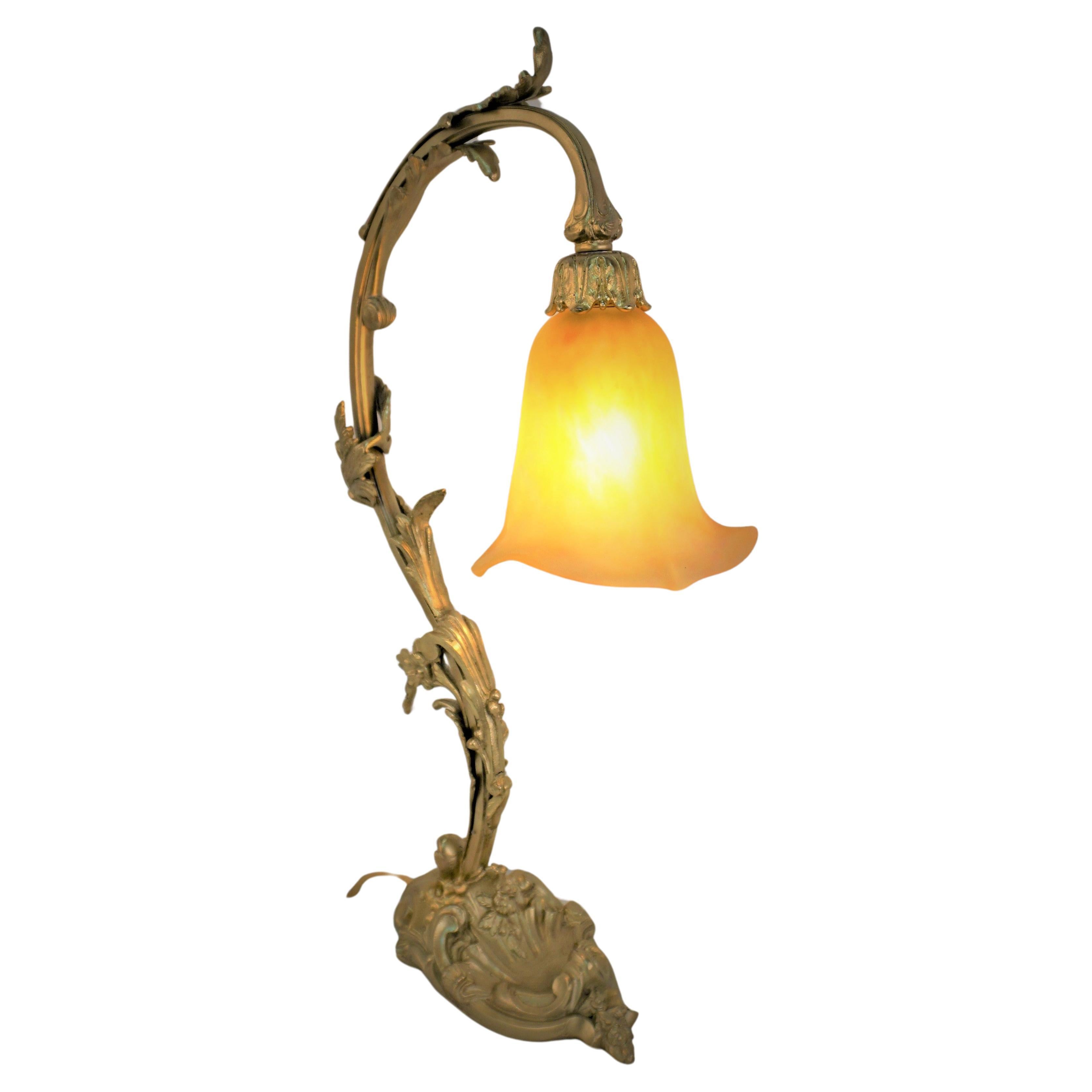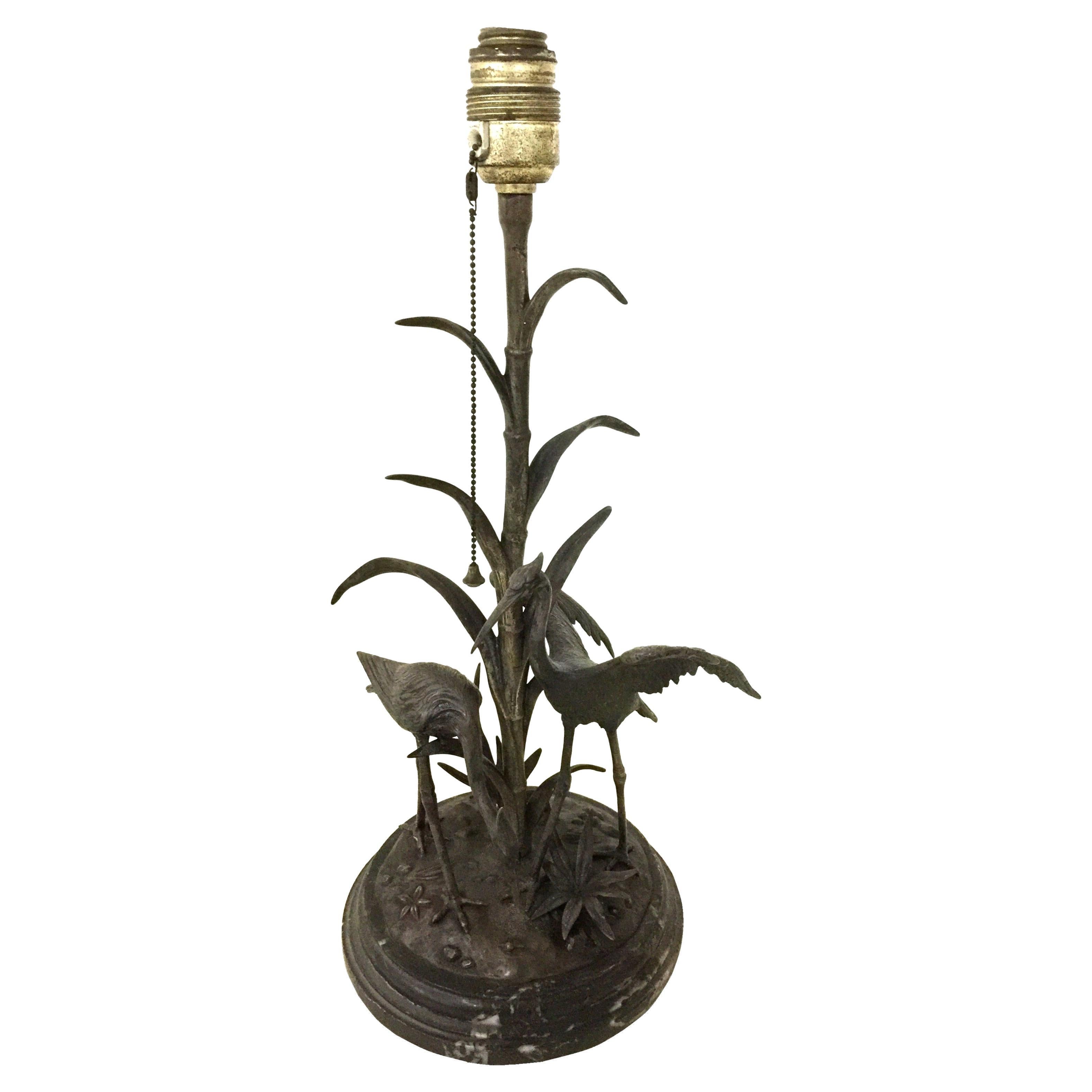Lamp, Sign: Daum Nancy, France, Style: Jugendstil, Art Nouveau, Liberty, 1904
About the Item
- Creator:Daum (Designer)
- Dimensions:Height: 42 in (106.68 cm)Diameter: 20 in (50.8 cm)
- Lampshade:Included
- Style:Art Deco (Of the Period)
- Materials and Techniques:
- Place of Origin:
- Period:1900-1909
- Date of Manufacture:1904
- Condition:Wear consistent with age and use.
- Seller Location:Ciudad Autónoma Buenos Aires, AR
- Reference Number:
Daum
For collectors, Daum is a name in the first rank of the French makers of art glass, along with those of Émile Gallé and René Lalique. Led in its early decades by the brothers Auguste (1853–1909) and Antonin Daum (1864–1931), the company, based in the city of Nancy, established its reputation in the Art Nouveau period, and later successfully adopted the Art Deco style.
In 1878, lawyer Jean Daum took over the ownership of a glassworks as payment for a debt and installed his sons as proprietors. Initially, Daum made glass for everyday purposes such as windows, watches and tableware, but the success that Gallé enjoyed at the 1889 Universal Exposition in Paris — the international showcase for which the Eiffel Tower was built — inspired the Daum brothers to begin making art-glass pieces. They produced popular works of cameo glass, a decorative technique in which an outer layer of glass is acid-etched or carved off to reveal the layer below, but Daum became best known for vessels and sculptures in pâte de verre — a painstaking method in which finely ground colored glass is mixed with a binder, placed in a mold and then fired in a kiln.
Though early Daum glass was never signed by individual artists, the firm employed some of the masters of the naturalistic, asymmetrical Art Nouveau style, including Jacques Grüber, Henri Bergé and Amalric Walter (whose first name is frequently misspelled). Daum also collaborated with furniture and metalware designer Louis Majorelle, who created wrought-iron and brass mounts for vases and table lamps. In the 1960s, Daum commissioned fine artists, most notably Salvador Dalí and sculptor César Baldaccini, to design glass pieces. As you see from the works offered on 1stDibs, Daum has been home to an astonishingly rich roster of creative spirits and is today a state-owned enterprise making pâte de verre figurines.
- ShippingRetrieving quote...Ships From: Ciudad Autónoma Buenos Aires, Argentina
- Return PolicyThis item cannot be returned.
- Vase, Sign: Daum Nancy, France, Style: Jugendstil, Art Nouveau, Liberty, 1904By DaumLocated in Ciudad Autónoma Buenos Aires, CSign: Daum Nancy Daum is the name of a factory established in 1875 in the city of Nancy, France. When the notary Jean Daum became the owner of an industrial furnace, that of Nancy G...Category
Antique Early 1900s French Art Nouveau Glass
MaterialsGlass
- Vase Sign: Daum Nancy, France , Style: Jugendstil, Art Nouveau, LibertyBy DaumLocated in Ciudad Autónoma Buenos Aires, CSign: Daum Nancy France Daum is the name of a factory established in 1875 in the city of Nancy, France. When the notary Jean Daum became the owner of an i...Category
Vintage 1910s French Art Deco Glass
MaterialsGlass
- Vase Sign: Daum Nancy France, Style: Jugendstil, Art Nouveau, LibertyBy DaumLocated in Ciudad Autónoma Buenos Aires, CSign: Daum Nancy glass with applications Daum is the name of a factory established in 1875 in the city of Nancy, France. When the notary Jean Daum became the owner of an industrial ...Category
Vintage 1920s French Art Nouveau Glass
MaterialsGlass
- Daum Nancy, France, Style: Jugendstil, Art Nouveau, Liberty, 1910By DaumLocated in Ciudad Autónoma Buenos Aires, CDaum Nancy Daum is the name of a factory established in 1875 in the city of Nancy, France. When the notary Jean Daum became the owner of an industrial furnace, that of Nancy Glass, ...Category
Vintage 1910s French Art Deco Glass
MaterialsGlass
- Vase, Daum Nancy France, Style: Jugendstil, Art Nouveau, LibertyBy DaumLocated in Ciudad Autónoma Buenos Aires, CDaum Nancy Daum is the name of a factory established in 1875 in the city of Nancy, France. When the notary Jean Daum became the owner of an industrial furnace, that of Nancy Glass, ...Category
Vintage 1920s French Art Deco Glass
MaterialsGlass
- Vase, Sign: Daum Nancy France, Style: Jugendstil, Art Nouveau, Liberty, 1910By DaumLocated in Ciudad Autónoma Buenos Aires, CSign: Daum Nancy France Daum is the name of a factory established in 1875 in the city of Nancy, France. When the notary Jean Daum became the owner of...Category
Vintage 1910s French Art Nouveau Glass
MaterialsGlass
- Daum Nancy Art Nouveau Table LampBy DaumLocated in Dallas, TXDaum Cameo Glass and Wrought Iron Maple Leaf Table Lamp, circa 1920 Art Nouveau Art Deco design. Mottled and variegated glass base with with carve...Category
Vintage 1920s French Art Deco Table Lamps
MaterialsArt Glass
- L. Bessin and Daum Nancy Art Nouveau LampBy Paul-Lucien Bessin, DaumLocated in NANTES, FRArt Nouveau lamp circa 1900. Patinated regula representing a nymph, signed L. Bessin for Paul Lucien Bessin. Glass paste tulip signed Daum Nancy. Electrified and in perfect condition...Category
Early 20th Century French Art Nouveau Table Lamps
MaterialsSpelter
- Daum Nancy Gilt Bronze Art Nouveau LampBy DaumLocated in Dallas, TXDaum Nancy French Art Nouveau Table Lamp. Circa 1900 Antique Art Nouveau French gilt bronze floral formed table lamp with Daum Nancy Mottled glass shade. The special shade speaks for itself and is in pristine condition emitting golds, purples, reds and oranges. The treasure here is the mystery museum quality gilt bronze art nouveau floral base which may be the most beautiful chased bronze base I have ever seen. That comes from someone who sells 25 Tiffany Studios and dozens of other Daum, Galle, Majorelle and Edgar Brandt lamps a year. This one wont last long. Shade signed: "Daum Nancy" Base not signed. Dimensions: Height: 17.5 Inches x Width 17 Inches (Shade) H: 6.25 x D: 6.25 Condition: Excellent with no damage or repairs. Some regilding. AVANTIQUES is dedicated to providing an exclusive curated collection of Fine Arts, Paintings, Bronzes, Asian treasures, Art Glass and Antiques. Our inventory represents time-tested investment quality items with everlasting decorative beauty. We look forward to your business and appreciate any reasonable offers. All of our curated items are vetted and guaranteed authentic and as described. Avantiques only deals in original antiques and never reproductions. We stand behind our treasures with a full money back return policy if the items are not as described. Please also consider Avantiques eclectic Art...Category
Antique Early 1900s French Art Nouveau Table Lamps
MaterialsBronze
- Daum Nancy Glass Art Nouveau Bronze Table LampBy DaumLocated in Fairfax, VABlown art glass by Daum, fantastic bronze base art nouveau table lamp. Professionally rewired.Category
Vintage 1910s French Art Nouveau Table Lamps
MaterialsBronze
- Daum Nancy LampBy DaumLocated in Buenos Aires, ArgentinaDaum Nancy lamp Art Deco period Origin France Circa 1930 Etched glass, wrought iron Incised and signed on screen and base with Daum Nancy and the cross...Category
Vintage 1930s French Art Deco Table Lamps
MaterialsWrought Iron
- Art Nouveau Lamp by Victor Saglier and Daum NancyBy Victor Saglier, DaumLocated in NANTES, FRGilt bronze lamp around 1900, probably by Majorelle executed by Victor Saglier. Stamped on the foot VS. Glass paste tulip signed Daum Nancy. Lamp electrified and in perfect condition. Total height: 38.5 cm - 15.15 in width: 15cm depth: 13cm weight: 2.3kg Victor Saglier (1809 - 1894) Victor Saglier is a ceramist and goldsmith known in particular for his creations in the Art Nouveau style of the late 19th century. He produces, among other things, objects in enamelled glass, gilded metal and numerous pieces of silverware. On his death, the company was bought by his brothers who continued production until 1948. Victor Saglier's objects are signed by the "VS" brand. Known for his Art Nouveau work, Saglier made several pieces for Louis Majorelle, Daum and Émile Gallé. Its style is typically French Art Nouveau in the language of the École de Nancy. He often drew inspiration from nature for his work, the logic of which helped design both forms and settings. The sign of master goldsmith Victor Saglier is an oval-shaped three-master sailboat surrounded by the letters V and S in a rectangle. Saglier made everyday objects such as glass vases, bowls and pitchers with metal mounts, planters, tea and coffee services and candlesticks in bronze or silver-yellow metal or cast zinc. On his death, the Victor Saglier company at 12 rue d'Enghien in Paris became Saglier Frères. It was run by his brothers Eugène and André until his death in 1948. Daum (French establishment created in 1878) is a glass and crystal workshop located in Nancy. Founded by the industrialist and notary Jean Daum, the workshop was then taken over by his sons Auguste and Antonin, who ran it during the Art Nouveau period. It was not until the Universal Exhibition of 1900 that the company was at the forefront of the decorative art scene, when Daum received the prestigious Grand Prix medal. At this time, Daum glass became more complex, acid treatment was often used in the cutting, enameling and etching of a piece to produce glass masterpieces. Daum also produces applied glass elements, such as handles and ornamental motifs in naturalistic shapes. The Daum brothers quickly became big names in Art Nouveau, rivaling the famous designer Émile Gallé, and established themselves as leaders in the field of decorative glass after his death. In 1906, Daum revived glass paste, a process by which glass is transformed into paste, then it is applied to the surface of a mold and fired. This technique originates from ancient Egypt. Today, Daum is the only industrial crystal manufacturer that uses the glass paste process for its glass objects and crystal sculptures. Following the First World War, Paul Daum began to develop works in the Art Deco style, moving away from naturalistic forms and turning to linear, angular, simplified forms and geometric patterns characteristic of the movement. After the Second World War, Henri and Michel Daum became interested in the transparency of glass and pure lines. Daum collaborates with a large number of famous artists, such as Louis Majorelle, Salvador Dalí, Hilton Mac Connico, Elizabeth Garouste and Mattia Bonetti to create glass paste objects.Category
20th Century French Art Nouveau Table Lamps
MaterialsBronze

